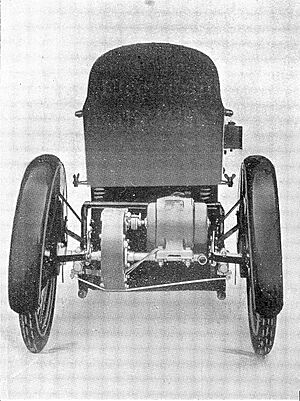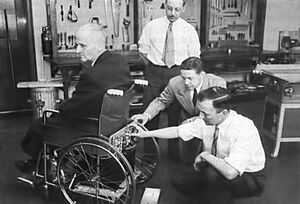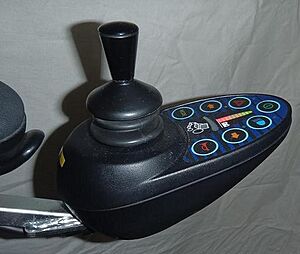Motorized wheelchair facts for kids
A motorized wheelchair, also called a powerchair or electric wheelchair, is a special type of wheelchair. Unlike a regular wheelchair that you push with your hands, a motorized wheelchair moves using an electric motor. It usually steers with a system called differential steering, which means the wheels on each side can move at different speeds or even in opposite directions to help it turn.
Motorized wheelchairs are super helpful for people who can't push a manual wheelchair themselves. They are also great for longer trips or on bumpy ground where pushing a manual chair would be too tiring. People with heart conditions or those who get tired easily also find them very useful.
Contents
How They Began
The idea of an electric chair started a long time ago! An electric tricycle was made in England by the R.A. Harding company in the 1930s. The electric-powered wheelchair as we know it was invented by George Klein. He worked for the National Research Council of Canada and created it to help soldiers who were injured during World War II.
How They Work
Motorized wheelchairs are designed to be very reliable. They are often the main way someone gets around. Because of this, they need to be strong and work well all the time.
Parts of a Powerchair
Powerchairs usually have four or six wheels. Most don't fold up, but some can be taken apart a bit for travel.
There are four main ways powerchairs can be driven:
- Front-wheel drive: The front wheels do the pulling.
- Centre-wheel drive: The middle wheels are powered, with smaller wheels at the front and back for balance.
- Rear-wheel drive: The back wheels do the pushing.
- All-wheel drive: All wheels are powered for extra grip.
The powered wheels are usually bigger than the smaller wheels that just roll along. Centre-wheel drive chairs have six wheels in total.

Some powerchairs can even have a special device called a kerb-climber. This helps the chair lift its front wheels over small kerbs, like those up to 10 centimeters (about 4 inches) high.
Sometimes, a regular manual wheelchair can get an electric boost! This can happen in a few ways:
- The electric motor can be built into the wheels you push, making it easier to move.
- A motor can be added underneath the wheelchair, pushing it forward.
Scientists have even experimented with powerchairs that use tracks instead of wheels, like a small tank, for rough ground. There are also chairs that can climb stairs! The Dean Kamen's iBOT chair could even "stand up" on its back wheels using special sensors.
Powering Up: Batteries
The electric motors in powerchairs get their energy from special rechargeable batteries. These are usually 12-volt batteries that can store a lot of power, from 12 to 80 ampere hours. Smaller batteries are often used in pairs to make sure the chair has enough power to last all day.
Batteries come in two main types:
- Wet-cell batteries: These contain liquid.
- Dry-cell batteries: These are sealed and don't have liquid. Dry-cell batteries are often preferred for powerchairs, especially if someone needs to travel on an airplane, because they are safer to transport.
Many powerchairs have a charger built right in, so you can just plug them into a wall outlet. Older or smaller chairs might use a separate charger.
Steering Your Chair
Most powerchairs are controlled with a joystick mounted on the armrest. This joystick lets you steer and can also have buttons to change how sensitive the chair is or to switch between different control modes. The joystick can often swing out of the way to make it easier to get in and out of the chair.
For people who can't use a hand controller, there are other options. Some chairs use "sip-and-puff" controllers, where you blow or sip into a tube to control the chair. Sometimes, the controller can even be placed at the back so a helper can drive the chair.
Scientists are even working on "mind-controlled" wheelchairs! These chairs would work by detecting brainwaves or nerve signals from sensors on your head or body.
Sitting Comfortably: Seats
The seat on a powerchair can be very simple or very fancy. Basic chairs might have a simple fabric seat and backrest. Others have extra padding, comfortable cushions, and even headrests. Some companies make special backrests and seat cushions for people who need more support or who need to prevent skin problems from sitting for a long time.
Leg rests can be part of the seat design and can even be powered, letting the user change their leg position. Some powerchairs can also tilt the seat back or recline, which helps people who can't sit upright for long periods. This also helps shift pressure and makes it easier to get in and out of the chair.
Some advanced powerchairs can even help the user stand up! The whole seat might lift up to standing height, or the seat, back, and leg rests move together to bring the user into an upright position. Some of these chairs can even move while the user is standing.
Where You Can Go: Environment
Powerchairs are designed for different places:
- Indoor chairs: These are narrow and short, making them easy to move around inside a house. They have simple controls and smooth tires that won't damage floors. They are not very stable outdoors.
- Indoor/outdoor chairs: These are still fairly small but have better batteries and grippy tires. They often have kerb-climbers. They are good for pavements but not rough terrain.
- Outdoor chairs: These have a long battery range, a wide base for stability, and large tires for comfort and handling on uneven ground. They can sometimes be used indoors if the space is large enough.
Some very large outdoor powerchairs are built for rough terrain, almost like small off-road vehicles!
Getting Around: Transportation
Most wheelchairs are tested to make sure they are safe to use in vehicles. This means they can be used facing forward in a car or van if the vehicle has special straps or a docking system to hold the wheelchair securely, and a way to secure the person in the chair.
Who Uses Powerchairs?
Powerchairs are usually given to people who can't use a manual wheelchair. However, sometimes the rules for getting a powerchair from health services can be strict. For example, in some places, if a person can walk even a little bit inside their home, they might not be eligible for a powerchair, even if walking is very difficult or they can't walk far outside. This means many people have to buy their own powerchairs or mobility scooters, which might not be exactly what they need but fit their budget.
It's important to remember that powerchairs aren't just for people who can't use manual chairs. Anyone with a condition that causes mobility issues, fatigue, or pain might find a powerchair helpful in certain situations.
Sports and Powerchairs
Yes, powerchairs are even used in sports! Sports like Powerchair Football and Power hockey have been created especially for power wheelchair users. There are even power wheelchairs built specifically for these sports.
What Are the Challenges?
Sometimes, powerchairs can be larger and heavier than manual wheelchairs. This can make it tricky to use them in some public transport spaces or on certain wheelchair lifts, which are often designed for smaller manual chairs. However, new designs are always being developed to help overcome these challenges.
See also
- Mobility scooter
- Motorized shopping cart
- Rehabilitation engineering
- Standing wheelchair
- Wheelchair ramp





